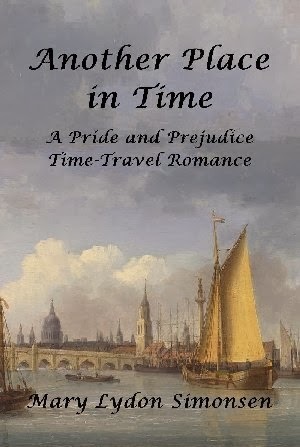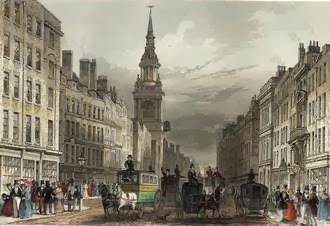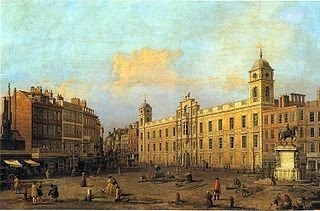An Interview with Fitzwilliam Darcy by Mary Simonsen
 Today, I am visiting with Jakki at Leatherbound Reviews where I interview Mr. Darcy about time travel in connection with my new release,
Another Place in Time
. Previously, I interviewed modern-day time traveler, Christine O'Malley, regarding her first impressions after her initial meeting with Fitzwilliam Darcy. You can read that post
here.
Today, I am visiting with Jakki at Leatherbound Reviews where I interview Mr. Darcy about time travel in connection with my new release,
Another Place in Time
. Previously, I interviewed modern-day time traveler, Christine O'Malley, regarding her first impressions after her initial meeting with Fitzwilliam Darcy. You can read that post
here.
Christine O'Malley also visited with Maria Grace on her blog Random Bits of Fascination where she wrote about what it would be like to visit Regency-Era London. I am reposting her blog post here.
An excerpt from Another Place in Time: Soon after the carriage exited Manchester Square, they plunged into the chaos that was London, the capital of the commercial world. The cacophony was extraordinary. Hackney drivers shouted, sellers advertised their wares, pamphleteers screamed scandalous headlines, and horses neighed. It was like New York City at rush hour, except with horses, dogs, cats, and the occasional pig thrown in for interest.
By Christine O'Malley, Time Traveler
Prior to journeying to London in 1812 with Fitzwilliam Darcy, I had visited modern London three times. I consider it to be the most vibrant city in the world—then and now. In 1812, London was the undisputed capital of the commercial world. Its main highway, the River Thames, was chock-a-block full of ships of every shape and size, and those ships carried every imaginable commodity. For the well-heeled of London, the world came to their doors with coffee, tea, spices, muslin, and so much more.
But London paid a price for its success. The only way to get around Town was by horse. As a result, its streets were clogged with even worse traffic than there is today, and you crossed the street at your peril. The most efficient way was to travel by river, but if you chose that route, you had best bring a bouquet of posies or a handkerchief dipped in vinegar as the Thames served as London’s sewer, serving more than one million people. Because the city was powered by coal, the beautiful dome of St. Paul’s Cathedral that Londoners see today was covered with soot as was Westminster Abbey and every other building (thus the reason for black umbrellas).
 London Street Scene
London Street SceneMy first stop on my tour of London with Fitzwilliam and Georgiana Darcy was Lackington’s, also known as the Temple of the Muses, a bookstore that would be the envy of any modern urban store. After returning to the carriage, Mr. Darcy ordered the driver to take us down the Strand where we were able to catch glimpses of the river traffic, St. Mary le Strand, Somerset House, and Northumberland House (now gone). Nearby Fleet Street served as headquarters to a vibrant press, and Ye Olde Cheshire Cheese, a pub still in existence, was serving pub grub and ale.
 Northumberland HouseAnother day, while Mr. Darcy rode with Mr. Bingley in Rotten Row, Georgiana and I paid a visit to Westminster Abbey, but the familiar narthex (vestibule) was not built until the mid 20th Century. We visited the south transept and the grave of Chaucer. Because later poets requested that they be buried near the first poet to write in the vernacular, the transept would come to be known as Poet’s Corner.
Northumberland HouseAnother day, while Mr. Darcy rode with Mr. Bingley in Rotten Row, Georgiana and I paid a visit to Westminster Abbey, but the familiar narthex (vestibule) was not built until the mid 20th Century. We visited the south transept and the grave of Chaucer. Because later poets requested that they be buried near the first poet to write in the vernacular, the transept would come to be known as Poet’s Corner.Georgiana and I also visited Carlton House. Fitzwilliam had been invited to join us, but because he disapproved of the Prince Regent’s lifestyle, he declined, preferring to spend his afternoon at Brooks’s, one of London’s many men’s clubs.
The White Tower (aka Tower of London) stood high above the city, but public executions at Tyburn (now the site of the Marble Arch) had ceased to provide entertainment for the public. Although Trafalgar Square had yet to be developed, Charles I was already sitting on his horse in front of what would become, two decades later, the National Gallery. After bumping along in a carriage, dodging hundreds of other conveyances, and stepping gingerly whenever we exited the carriage, we returned to the Darcy home on Manchester Square.
While Georgiana enjoyed London during the Season and visiting the shops, Darcy loved London for its history, architecture, and energy. During his time in Baltimore, when he saw photographs of modern London, he nodded his head in approval. Although the man’s sensibilities were firmly rooted in the early 19th Century, he admired the engineering required to build the Gherkin, the efficiency of the Underground, and the crowds walking the streets listening to iTunes and talking on their smart phones because Mr. Darcy loves gadgets! Unfortunately for Mr. Darcy, cell phone reception in 1812 is terrible!
Another Place in Time is available at Barnes and Noble in e-book and on Amazon in e-book and in paperback.
Published on February 18, 2014 09:11
No comments have been added yet.
What readers are saying about The Second Date
I loved reading about the history of the families and how it was woven into the story. I felt right at home reading about Sonia and her family. It reminded me so much of my childhood growing up in the
I loved reading about the history of the families and how it was woven into the story. I felt right at home reading about Sonia and her family. It reminded me so much of my childhood growing up in the South and I found myself laughing out loud when reading about the one room no one was allowed to sit in with the plastic on the furniture and having to have a mediator at funerals. - C. Mason
Sonia Amundsen is a likable and feisty heroine, who is starting to think she isn't going to find her perfect man. It's not a predictable path to love and I really I loved the romance. The Second Date is an engaging picture of a close knit and vibrant group of friends and family in a community that has its share of fun, food, chaos and craziness. I found it a fascinating peek into the complexities and pressures of their lives and romances. It has depth and insight into the things in our pasts, our lives and families that make us who we are, with warmth, humour and realism. - Portia ...more
Sonia Amundsen is a likable and feisty heroine, who is starting to think she isn't going to find her perfect man. It's not a predictable path to love and I really I loved the romance. The Second Date is an engaging picture of a close knit and vibrant group of friends and family in a community that has its share of fun, food, chaos and craziness. I found it a fascinating peek into the complexities and pressures of their lives and romances. It has depth and insight into the things in our pasts, our lives and families that make us who we are, with warmth, humour and realism. - Portia ...more
- Mary Lydon Simonsen's profile
- 181 followers



